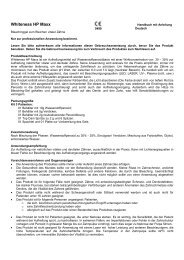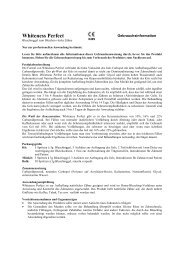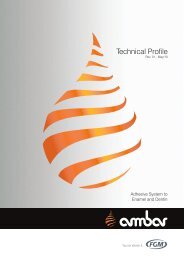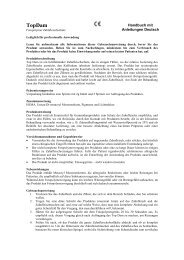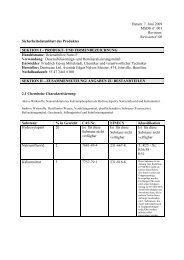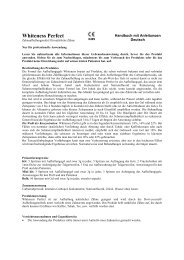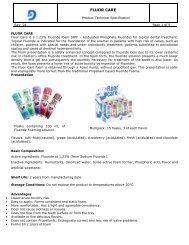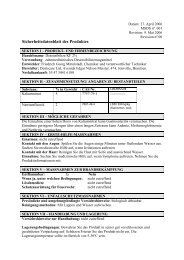orthocem - FGM-Dental: Startseite
orthocem - FGM-Dental: Startseite
orthocem - FGM-Dental: Startseite
- No tags were found...
Create successful ePaper yourself
Turn your PDF publications into a flip-book with our unique Google optimized e-Paper software.
Technical ProfileRev. 01 - May/10Primer + Adhesivo<strong>orthocem</strong>Cement / Adhesive for OrthodonticBrackets BondingYou’re Worth It.
<strong>orthocem</strong>INDEX1. Introduction2. Basic Composition3. Product Presentation4. Main Characteristics and Advantages5. Indications for Use6. Physico-Chemical and Mechanical Properties6.1 Immediate Bond Strength6.2 Bond Strength After Aging6.3 Color Change After Aging7. Instructions for Use8. Conservation and Storage9. References010102020202020303040505
<strong>orthocem</strong>1. IntroductionThe adhesive dentistry along with the possibility of bonding orthodontic brackets directly tothe enamel surfaces by means of an adhesive has changed significantly the orthodonticsspecialty. This procedure simplified the use of fixed orthodontic appliances, reducing significantlythe number of steps required for their placement and shortening the treatment time. Otherimportant advantages that could be reached were greater biofilm control, reduction of gingivitisand hyperplasia, no need to use orthodontic spacers, elimination of the spaces between teethafter removal of cemented orthodontic bands, bonding of brackets in partially erupted teeth, lowprobability of decalcifications due to microleakage, easy caries lesion detection and enhancedesthetics.Since initially proposed by Newman et al. (1968), the bracket bonding procedure has beenimproved so as to become a faster and more effective clinical step. At the beginning, fixedorthodontics required the use of chemically-cure resin materials to bond metal brackets to thetooth, demanding professional practice due to the reduced working time. The technologicaladvances have enabled the development of several cementation systems with particular features.The resin cements now include a photo-initiator, making them light cured and allowing the controlof the working time by the professional. At the same time, glass ionomer cements were developedand used for bracket bonding with the additional benefit of fluoride release. However they were stillchemically cured and presented lower mechanical strength than the resin cements.Despite the benefits of adhesive bracket bonding, these materials are still challenged in theoral cavity. Unlike an adhesive system used for direct restorations, orthodontic bonding systemsshould have enough strength to keep the brackets into position throughout the orthodontictreatment but also offer no excessive resistance to its removal at the end of the orthodontictreatment so as to avoid damage to the tooth structure.Although highly relevant, the bond strength of an adhesive for bracket bonding is not the onlyfactor that accounts for its clinical success. The material should also be able to withstand watersorption so as to avoid bonding failures and undesirable discoloration. Among other factors, thematerial should have suitable viscosity to allow a correct positioning of the bracket (important fortooth movement) and a simplified (with fewer steps) and feasible protocol.The mechanism by which the cement adheres to the tooth is based on the same concepts ofthe adhesive restorative dentistry. The enamel etching creates microporosities on the enamelsurface that allows micromechanical interlocking of the adhesive, which is in turn responsible forbracket retention. After curing the adhesive provides the stability required to keep the bracket inposition and to withstand the orthodontic movement.OrthoCem (<strong>FGM</strong>) is a light cured material, which allows control of the working time andimmediate placement of archwires after light curing. The light cured cements usually require theprimer and the bonding adhesive. These two cardinal steps of priming and bonding can beaccomplished separately or simplified in a single product. The production of a single componentproduct containing the primer and bonding adhesive reduces the clinical steps during bonding.OrthoCem (<strong>FGM</strong>) is a single component material and does not require previous adhesiveapplication. Therefore, OrthoCem (<strong>FGM</strong>) requires only two clinical steps for bonding: 1) enamelacid etching and; 2) application of OrthoCem to the undersurface of the bracket, bracketpositioning and light curing. Furthermore this new orthodontic bonding paste contains fluorideand presents a special viscosity developed to ensure easy bracket positioning and removal ofexcess without bracket displacement.2. Basic CompositionMethacrylate monomers such as BisGMA, TEGDMA, phosphate methacrylates, stabilizers,camphorquinone, co-initiator and silicium dioxide nanoparticles.01
<strong>orthocem</strong>3. Product PresentationPackage containing 1 syringe with 4 grams, 1 etchant (CondAc 37) and instructions for theprofessional.4. Indications for UseBonding metal, ceramic and polycarbonate brackets to enamel surface.5. Main Characteristics and Advantages Practical: primer and adhesive in the same syringe, no need of previous adhesive application(reduction of clinical steps);Adequate Bond Strength: balanced bond strength so as to avoid adhesive failure duringorthodontic treatment and allow easy bracket removal at the end of the orthodontic treatment;Adequate Viscosity: facilitates bracket placement;Light Cured: allows placement of the archwire immediately after bracket bonding.6. Physical-Chemical and Mechanical Properties6.1 Immediate Bond StrengthThe bond strength of brackets and accessories to enamel should be strong enough to withstandthe mastication forces and the immediate stress required for correcting the positioning of teeth aswell as to control tooth movement in the three planes of space. At the same time, the bond strengthshould permit bracket debonding without damaging the enamel surfaces. Several studies havesuggested that bond strength values in the range of 2,8 to 15 MPa are suitable for clinical cases.The hydrophobic features of the material demand an adequate isolation of the operative field fromsaliva contamination before the bonding protocol. This is one of the common factors responsiblefor adhesive bracket failure. Under contamination, saliva infiltrates into the microporositespreventing the proper penetration of the adhesive on the etched enamel surface. This isparticularly more often in posterior and partially erupted teeth.The shear bond strength values of metal brackets to bovine enamel produced with someorthodontic adhesive pastes available in the market are presented in Figure 1.Competitor ACompet itor BCompet itor CCompet itor DOrthoCem (<strong>FGM</strong>)Figure 1: Shear bondstrength of metal bracketto bovine enamel.Source: <strong>FGM</strong> Produtos OdontológicosLtda. (Different letters indicatestatistically different means (p
<strong>orthocem</strong>The results were statistically compared using one-way analysis of variance and Tukey’s test at aconfidence level of 95%. Observe that there are two groups of materials with statistically similarmeans. The first group is composed of OrthoCem (<strong>FGM</strong>), Competitor C and Competitor D. Thesecond group is composed of materials with a shear bond strength of approximately 10 MPa(Competitor A and Competitor B).6.2 Bond Strength After AgingFor comparative purposes the bonding pastes OrthoCem (<strong>FGM</strong>) and Competitor D weresubmitted to thermocycling to accelerate the aging of the material. Specimens of bovine enamelwith bonded brackets were submitted to 10,000 thermocycles between 5ºC and 55ºC. The bondstrength was determined before and after aging and the data was statistically analyzed by a twowayanalysis of variance and Tukey’s test at a confidence level of 95%. The results are depicted inFigure 2.ImmediateAfter agingOrthoCem (<strong>FGM</strong>)Competitor DFigure 2: Shear bond strengthbefore and after aging.Source: <strong>FGM</strong> Produtos Odontológicos Ltda.(Different letters indicate statistically differentmeans (p
<strong>orthocem</strong>Competitor BCompetitor CCompetitor EOrthoCem (<strong>FGM</strong>)Competitor DFigure 3: Color change beforeand after aging by thermocycling.Source: <strong>FGM</strong> Produtos Odontológicos Ltda.(Different letters indicate statistically differentmeans (p
<strong>orthocem</strong>Step-by-StepThe following clinical case demonstrates the steps required for placement of fixed appliances withOrthoCem. The procedure is very simple and fast, since the bonding is performed with a singlecomponent bonding paste (primer + adhesive).1. 2. 3.1. Initial aspect of patient’s teeth. 2. After prophylaxis, the etchantCondAc 37 (<strong>FGM</strong>) was applied tothe surface of the teeth for 15seconds.3. Teeth were rinsed and air-dried.4. 5. 6.4. Application of OrthoCem(<strong>FGM</strong>) bonding paste on thebracket’s base.5. Bracket positioning on thetooth surface.6. The adhesive excess is easilyremoved with an explorer.7. 8a. 8b.7. Light curing for 20 seconds onthe bracket sides.Clinical case kindly provided by Dr. Rodrigo Stanislawczuk.8. Conservation and StorageDo not expose materials to elevated temperatures or intense light.Do not store material in proximity to eugenol-containing products as this may inhibit the properadhesive curing.Store the product at temperature between 15 and 30ºC.Do not use the product after the expiration date.9. References8a and 8b. The archwire can be inserted immediately after lightcuring.Bishara S, Laffoon J, Vonwald L, Warren J. The effect of repeated bonding on the shear bondstrength of different orthodontic adhesives. Am J Orthod Dentofacial Orthop 2002; 121: 521-5.Fróes Salgado NR, Francci C. Colagem de bráquetes em ortodontia: uma revisão. POS Perspect.Oral Sci. 2009 Ago; 1 (1): 49-55.056.
<strong>orthocem</strong>Ireland A, Sherriff M. An investigation into the use of an anaerobic adhesive with two commerciallyavailable orthodontic brackets. <strong>Dental</strong> Materials 2006; 22: 112–118.Klocke A, Kahl-Nieke B. Influence of force location in orthodontic shear bond strength testing.<strong>Dental</strong> Materials 2005; 21: 391–396.Lunardi N. Análise in vitro da resistência ao cisalhamento de bráquetes metálicos submetidos areciclagem repetida fixados com diferentes materiais. Dissertação, UNICAMP (2004).Maccoll Ga, Rossouw Pe, Titley Kc, Yamin C. The relationship between bond strength andorthodontic bracket base surface area with conventional and microetched foil-mesh bases. Am JOrthod Dentofacial Orthop. 1998; 113: 276-81.Manning N, Chadwick AM, Plunkett D, Macfarlane TV. A randomized clinical trial comparing “onestep”and “two-step” orthodontic bonding systems. Journal of Orthodontics 2006; 33: 276-283.Marotti J, Vieira GF, Pereira CAB. Relação entre a dureza e o manchamento das resinascompostas. EPG Ver Pós Grad 2006; 13 (2): 168-174.Newman GV, Snyder WH, Wilson Jr CE. Acrylic adhesives for bonding attachments to toothsurfaces. Angle Orthod. 1968 Jan; 38 (1): 12-18.Pickett K, Sadowsky L, Jacobson A, Lacefield W. Orthodontic In Vivo Bond Strength:Comparison with In Vitro Results. The Angle Orthodontist: 2003; 71: 141–148.Regan D, Lemasney B, Van Noort R. The tensile bond strength of new and rebonded stainlesssteel orthodontic brackets. Eur J Orthod 1993; 15: 125-35.Thiyagarajah S, Spary DJ, Rock WP. A clinical comparison of bracket bond failures in associationwith direct and indirect bonding. Journal of Orthodontics 2006; 33: 198-204.Vichi A, Ferrari M, Davidson CL. Color and opacity variations in three different resin-basedcomposite products after water aging. <strong>Dental</strong> Materials 2004; 20: 530-534.Wenger NA, Deacon S, Harradine NWT. A randomized control clinical Trial investigatingorthodontic Bond failure rates when using Orthosolo universal Bond enhancer compared to aconventional bonding primer. Journal of Orthodontics 2008; 35: 27-32.06
<strong>orthocem</strong>Manufactured by:DENTSCARE LTDAAv. Edgar Nelson Meister, 474Bairro: Distrito Industrial89219-501 – Joinville – SCPhone: (047) 34416100 /Fax: (47) 34273377Operating license MS P5X44XY0XX28CNPJ: 05.106.945/0001-06BRAZILIAN INDUSTRYANVISA registry n° 80172310043Responsible Technician: Friedrich Georg MittelstadtCRQ: 13100147-SCDistributted by<strong>FGM</strong> PRODUTOS ODONTOLÓGICOS LTDA.Operating license MS 103.113-9CNPJ 03.397.905/0001-35BRAZILIAN INDUSTRYCustomer service:+ 55 (47) 344161000800 644 6100www.fgm.ind.brcontato@fgm.ind.brThis material has been developed solely for use in dentistry. Processing should be carried out strictly according to theinstructions for Use. Liability cannot be accepted for damages resulting from failure to observe the Instructions or thestipulated area of application. Besides that, the user is responsible for testing the material for its suitability and use for anypurpose not explicitly stated in the Instructions.Rev: 0107
+55 47 3441 6100 | www.fgm.ind.br | twitter.com/fgmwhiteness | youtube.com/fgmprodutosodonto | contact@fgm.ind.brAv. Edgar Nelson Meister, 474 . Distrito Industrial . CEP 89219-501 . Joinville . SC . BrazilYou’re Worth It.



